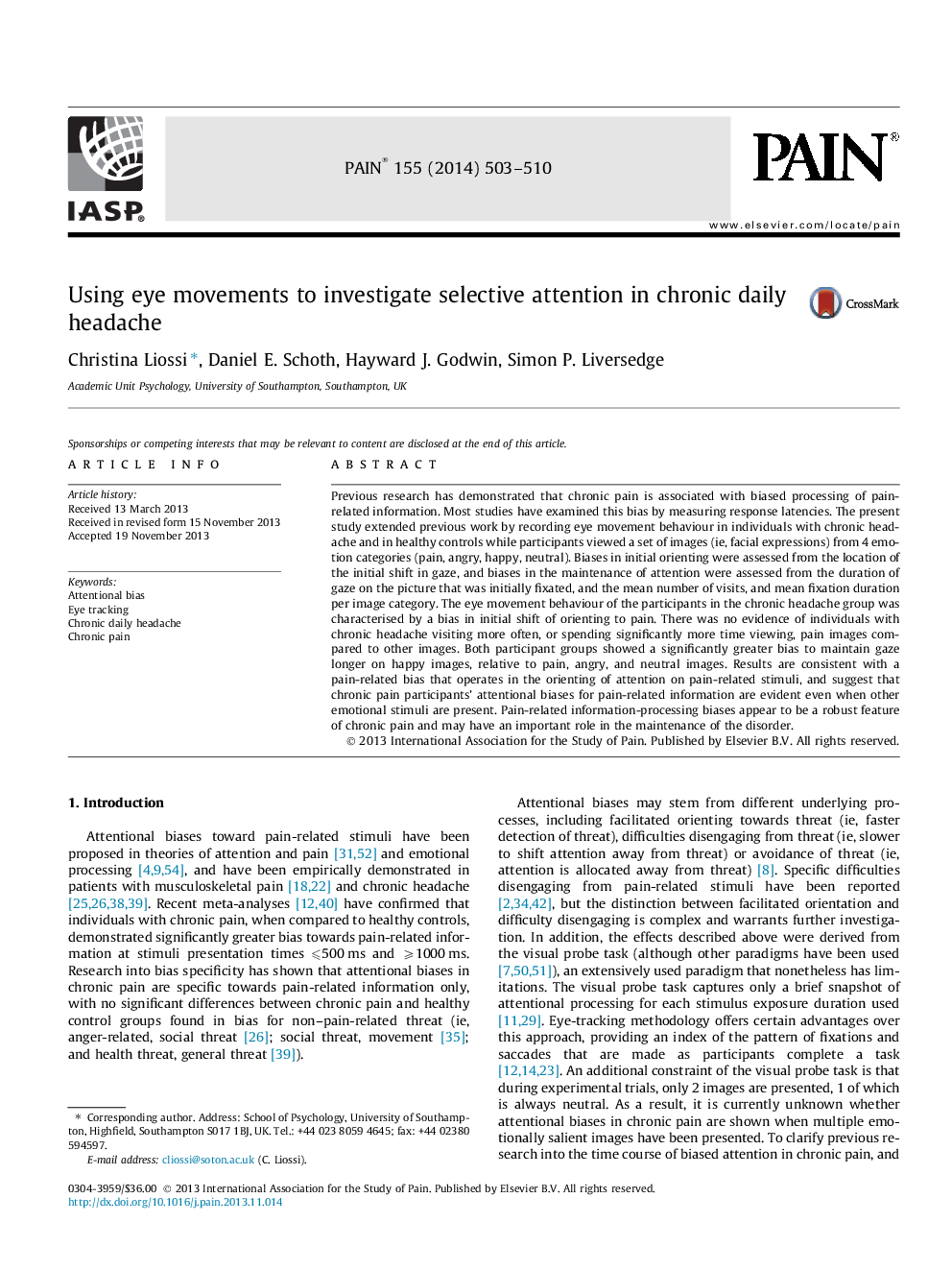| کد مقاله | کد نشریه | سال انتشار | مقاله انگلیسی | نسخه تمام متن |
|---|---|---|---|---|
| 10450082 | 918345 | 2014 | 8 صفحه PDF | دانلود رایگان |
عنوان انگلیسی مقاله ISI
Using eye movements to investigate selective attention in chronic daily headache
ترجمه فارسی عنوان
با استفاده از حرکات چشم برای بررسی توجه انتخابی در سردرد روزانه مزمن
دانلود مقاله + سفارش ترجمه
دانلود مقاله ISI انگلیسی
رایگان برای ایرانیان
کلمات کلیدی
تعصب توجه ردیابی چشم، سردرد مزمن روزانه، درد مزمن،
ترجمه چکیده
تحقیقات قبلی نشان داده است که درد مزمن با فرایندهای غلط مرتبط با اطلاعات مربوط به درد همراه است. اکثر مطالعات این تعصبات را با اندازه گیری تأخیرات پاسخ بررسی کرده اند. این مطالعه از طریق بررسی حرکات چشم در افراد مبتلا به سردرد مزمن و کنترل های سالم انجام شد. در حالی که شرکت کنندگان مجموعه ای از تصاویر (یعنی عبارات صورت) از 4 دسته احساسات (درد، عصبانی، شاد و خنثی) را مشاهده کردند. بی نظمی در جهت گیری اولیه از محل تغییر اولیه در چشم بررسی شد و تعصبات در حفظ توجه از مدت زمان مشاهده بر روی تصویر که در ابتدا ثابت شد، و میانگین تعداد بازدیدها و میانگین مدت زمان ثابت در هر دسته بندی تصویر رفتار جنبش چشم شرکت کنندگان در گروه سردرد مزمن با تبعیض اولیه در جهت گیری به درد مشخص شد. هیچ مدرکی از افراد مبتلا به سردرد مزمن وجود نداشته و یا زمان زیادی را صرف دیدن، تصاویر درد در مقایسه با سایر تصاویر دیده اند. هر دو گروه شرکت کننده نشان دادند که تعصب به طور قابل توجهی بیشتر برای حفظ نگاه دیگر به تصاویر شاد، نسبت به درد، عصبانی، و عکس های خنثی. نتایج مطابق با تعصب مربوط به درد است که در جهت توجه به محرک های مرتبط با درد عمل می کند و نشان می دهد که تعصب توجه های شرکت کنندگان در درد مزمن برای اطلاعات مربوط به درد، حتی زمانی که سایر محرک های احساسی وجود دارد، مشهود است. به نظر میرسد اختلالات پردازش اطلاعات مربوط به درد، یک ویژگی قوی از درد مزمن است و ممکن است نقش مهمی در حفظ اختلال داشته باشد.
موضوعات مرتبط
علوم زیستی و بیوفناوری
علم عصب شناسی
علوم اعصاب سلولی و مولکولی
چکیده انگلیسی
Previous research has demonstrated that chronic pain is associated with biased processing of pain-related information. Most studies have examined this bias by measuring response latencies. The present study extended previous work by recording eye movement behaviour in individuals with chronic headache and in healthy controls while participants viewed a set of images (ie, facial expressions) from 4 emotion categories (pain, angry, happy, neutral). Biases in initial orienting were assessed from the location of the initial shift in gaze, and biases in the maintenance of attention were assessed from the duration of gaze on the picture that was initially fixated, and the mean number of visits, and mean fixation duration per image category. The eye movement behaviour of the participants in the chronic headache group was characterised by a bias in initial shift of orienting to pain. There was no evidence of individuals with chronic headache visiting more often, or spending significantly more time viewing, pain images compared to other images. Both participant groups showed a significantly greater bias to maintain gaze longer on happy images, relative to pain, angry, and neutral images. Results are consistent with a pain-related bias that operates in the orienting of attention on pain-related stimuli, and suggest that chronic pain participants' attentional biases for pain-related information are evident even when other emotional stimuli are present. Pain-related information-processing biases appear to be a robust feature of chronic pain and may have an important role in the maintenance of the disorder.
ناشر
Database: Elsevier - ScienceDirect (ساینس دایرکت)
Journal: PAIN® - Volume 155, Issue 3, March 2014, Pages 503-510
Journal: PAIN® - Volume 155, Issue 3, March 2014, Pages 503-510
نویسندگان
Christina Liossi, Daniel E. Schoth, Hayward J. Godwin, Simon P. Liversedge,
